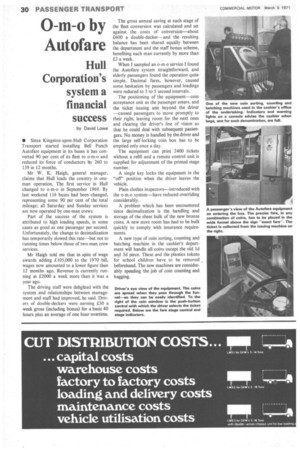0-m-a by Autofare
Page 32

If you've noticed an error in this article please click here to report it so we can fix it.
Hull Corporation's system a financial success
by David Lowe • Since Kingston-upon-Hull Corporation Transport started installing Bell Punch Autofare equipment in its buses it has converted 90 per cent of its fleet to o-m-o and reduced its force of conductors by 260 to 139 in 12 months.
Mr W. K. Haigh, general manager, claims that Hull leads the country in oneman operation. The first service in Hull changed to o-m-o in September 1969. By last weekend 116 buses had been changed, representing some 90 per cent of the total mileage; all Saturday and Sunday services are now operated by one-man crews.
Part of the success of the system is attributed to high loading speeds, in some cases as good as one passenger per second. Unfortunately, the change to decimalization has temporarily slowed this rate—but not to running times below those of two-man crew services.
Mr Haigh told me that in spite of wage awards adding £105,000 to the 1970 bill, wages now amounted to a lower figure than 12 months ago. Revenue is currently running at £2000 a week more than it was a year ago.
The driving staff were delighted with the system and relationships between management and staff had improved, he said. Drivers of double-deckers were earning £30 a week gross (including bonus) for a basic 40 hours plus an average of one hour overtime.
• The gross annual saving at each stage of the fleet conversion was calculated and set against the costs of conversion—about
£600 a double-decker and the resulting balance has been shared equally between the department and the staff bonus scheme, benefiting each man currently by more than £3 a week.
When I sampled an o-m-o service I found the Autofare system straightforward, and elderly passengers found the operation quite simple. Decimal fares, however, caused some hesitation by passengers and loadings were reduced to 3 to 5 second intervals.
The positioning of the equipment—coin acceptance unit as the passenger enters, and the ticket issuing unit beyond the driver —caused passengers to move promptly to their right, leaving room for the next ones and clearing the driver's line of vision so that he could deal with subsequent passengers. No money is handled by the driver and the large self-locking coin box has to be emptied only once a day.
The equipment can print 2400 tickets without a refill and a remote control unit is supplied for adjustment of the printed stage number.
A single key locks the equipment in the "off" position when the driver leaves the vehicle. • Plain clothes inspectors—introduced with the o-m-o system—have reduced overriding considerably.
A problem which has been encountered since decimalization is the handling and storage of the sheer bulk of the new bronze coins. A new store room has had to be built quickly to comply with insurance requirements.
A new type of coin sorting, counting and batching machine in the cashier's department will handle all coins except the old ld and 3d piece. These and the plastics tokens for school children have to be removed beforehand. The new machines are considerably speeding the job of coin counting and bagging.




































































































